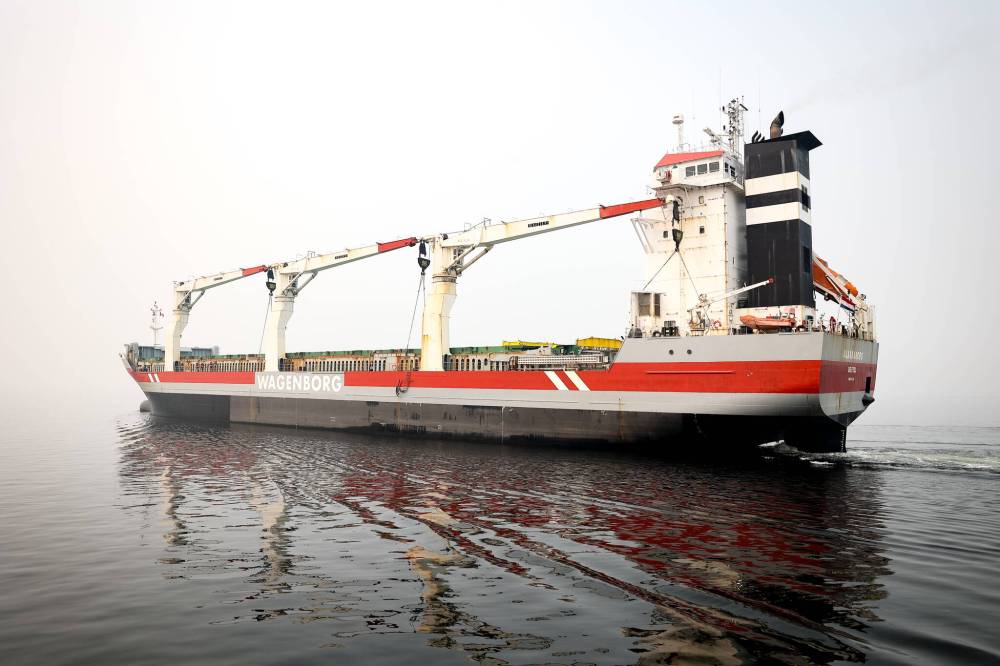‘Perfect timing’ as feds, province provide $80M for Churchill port Investment in link to European trade touted
Read this article for free:
or
Already have an account? Log in here »
To continue reading, please subscribe:
Monthly Digital Subscription
$0 for the first 4 weeks*
- Enjoy unlimited reading on winnipegfreepress.com
- Read the E-Edition, our digital replica newspaper
- Access News Break, our award-winning app
- Play interactive puzzles
*No charge for 4 weeks then price increases to the regular rate of $19.00 plus GST every four weeks. Offer available to new and qualified returning subscribers only. Cancel any time.
Monthly Digital Subscription
$4.75/week*
- Enjoy unlimited reading on winnipegfreepress.com
- Read the E-Edition, our digital replica newspaper
- Access News Break, our award-winning app
- Play interactive puzzles
*Billed as $19 plus GST every four weeks. Cancel any time.
To continue reading, please subscribe:
Add Free Press access to your Brandon Sun subscription for only an additional
$1 for the first 4 weeks*
*Your next subscription payment will increase by $1.00 and you will be charged $16.99 plus GST for four weeks. After four weeks, your payment will increase to $23.99 plus GST every four weeks.
Read unlimited articles for free today:
or
Already have an account? Log in here »
Hey there, time traveller!
This article was published 04/02/2025 (305 days ago), so information in it may no longer be current.
Manitoba’s waterway link to European trade — the Port of Churchill — was the recipient of nearly $80 million in funding announced one day after Canada avoided sweeping tariffs by U.S. President Donald Trump.
“The timing couldn’t be more perfect,” Premier Wab Kinew said Tuesday, standing beside federal ministers and Port of Churchill leadership.
Building up Canada’s only deep-water Arctic seaport connected to rail benefits Canadians on several levels, the premier said: it bolsters the local economy, creates a new trade route to global markets and shows the U.S. that Manitoba has an Arctic presence.
“Arctic security is something we’re both interested in,” Kinew said. “I look forward to hopefully being able to take some of our American friends to Churchill soon and show off this great port, this amazing asset.”
RUTH BONNEVILLE / FREE PRESS Premier Wab Kinew shakes hands with Chris Avery, CEO, Arctic Gateway Group after his announcement on new Arctic Gateway funding at the VIA Rail Station with federal ministers and business leaders in the north Tuesday.
The funds, tabbed jointly by Manitoba and Ottawa, builds on decades of investment in the area, Kinew said.
Last year, the two governments committed $60 million to begin port upgrades and finish the Hudson Bay Railway’s stabilization.
The feds have invested $277 million over the past six years to restore the railway and port. The rail line runs from The Pas to Churchill. The port makes Manitoba a “Maritime province,” politicians say, because it leads to the ocean.
“In these unpredictable times … investing in the North, in the Arctic is more important than ever,” said Dan Vandal, MP for Saint Boniface–Saint Vital.
Previous money has been spent on revitalizing the rail line, which was washed out in 2017. The line underwent years of neglect under private ownership, said Chris Avery, the chief executive of Arctic Gateway Group.
“In these unpredictable times … investing in the North, in the Arctic is more important than ever.”–Dan Vandal, MP for Saint Boniface–Saint Vital
The organization — comprised of 41 First Nations and Bayline communities in the region — took over the railway and port in 2018. The land link is the only surface option available year-round connecting several northern communities to southern locales like The Pas.
“I’m told it’s (now) in better condition than it has ever been,” said Avery, who’s been CEO for roughly six months.
Revitalization of the rail line is about 85 per cent complete, Avery said. There are more than 70 bridges along the path; once reconstruction is finished, there will be ongoing maintenance costs. The line runs through boggy land.
Arctic Gateway has also already directed some funding to the port. It accepted its first cruise ship in more than a decade two summers ago. HudBay Minerals shipped 10,000 metric tonnes of zinc concentrate — from a Snow Lake mine — to Europe last August via the Port of Churchill.
“We have a pathway to see that (shipment) doubling this year,” Avery said.
SUPPLIED An export shipment of critical minerals leaves the Port of Churchill for the first time in more than two decades in August.
It includes building storage units and infrastructure to hold goods like critical minerals and wheat. Government money will be used to restore the port’s wharf, which has faced years of decay, Avery said.
HudBay will ship 20,000 metric tonnes of zinc concentrate through the port this year, the company’s vice-president pledged Tuesday.
The Arctic port is operational for about four months of the year, Avery said. Arctic Gateway is working with University of Manitoba researchers to understand how long the port’s sea lanes can be open, and how the environment may change that in the future.
A report is expected to be published later this year. Preliminary results suggest the sea lanes could be open six months annually, Avery said.
More frequent natural disasters due to climate change and labour disputes at Canadian ports are part of the reason why having a functional Port of Churchill is important, Avery said.
“The Port of Churchill will never replace the Port of Vancouver, but it will be an option for Canada.”
Last year’s funding announcement drew delegates from Finland, Denmark, Sweden, Norway and Iceland. It’s still “early days” to gauge European demand, Avery said. American trade is another goal despite the threat of 25 per cent tariffs on Canadian goods Trump has promised. The tariffs were paused Monday for 30 days.
Arctic Gateway Group has been signing deals to bolster its supply chain. In 2024, it inked memorandums of understanding with Sakku Investments Corp., which represents the interests of Inuit in Nunavut’s Kivalliq region, and an economic development group from Tisdale, Sask.
On its website, Arctic Gateway advertises the port as a route to eliminate “time-consuming and high-cost” transportation through the Great Lakes and St. Lawrence Seaway.
“The Port of Churchill will never replace the Port of Vancouver, but it will be an option for Canada.”–Chris Avery, the chief executive of Arctic Gateway Group
The organization has conversed with Canada’s department of defence about Arctic security, Avery said.
Politicians and First Nations chiefs touted Arctic Gateway’s ownership of the railway and port — and the local job creation — as advancement of economic reconciliation.
“This represents for us a beacon of hope,” said E.J. Fontaine, chief of Sagkeeng First Nation.
On Tuesday, the federal government announced more than $2.3 million for partnerships with Indigenous governments and University College of the North to build workforce capacity in mining. Sagkeeng First Nation will receive $218,500, which will be used to train 120 people, Fontaine said.
Grain regularly shipped through the Port of Churchill before the Canadian Wheat Board was dismantled in 2012. Imports like phosphorus from Europe or the U.S. — for making fertilizer — are expected in the future, Avery said.
The port first opened in 1931. Canadian National Railway owned the Hudson Bay Railway until 1997. The route was acquired by Denver-based Omnitrax before Arctic Gateway Group took over.
gabrielle.piche@winnipegfreepress.com

Gabrielle Piché reports on business for the Free Press. She interned at the Free Press and worked for its sister outlet, Canstar Community News, before entering the business beat in 2021. Read more about Gabrielle.
Every piece of reporting Gabrielle produces is reviewed by an editing team before it is posted online or published in print — part of the Free Press‘s tradition, since 1872, of producing reliable independent journalism. Read more about Free Press’s history and mandate, and learn how our newsroom operates.
Our newsroom depends on a growing audience of readers to power our journalism. If you are not a paid reader, please consider becoming a subscriber.
Our newsroom depends on its audience of readers to power our journalism. Thank you for your support.
History
Updated on Tuesday, February 4, 2025 6:35 PM CST: Adds quotes, photo










